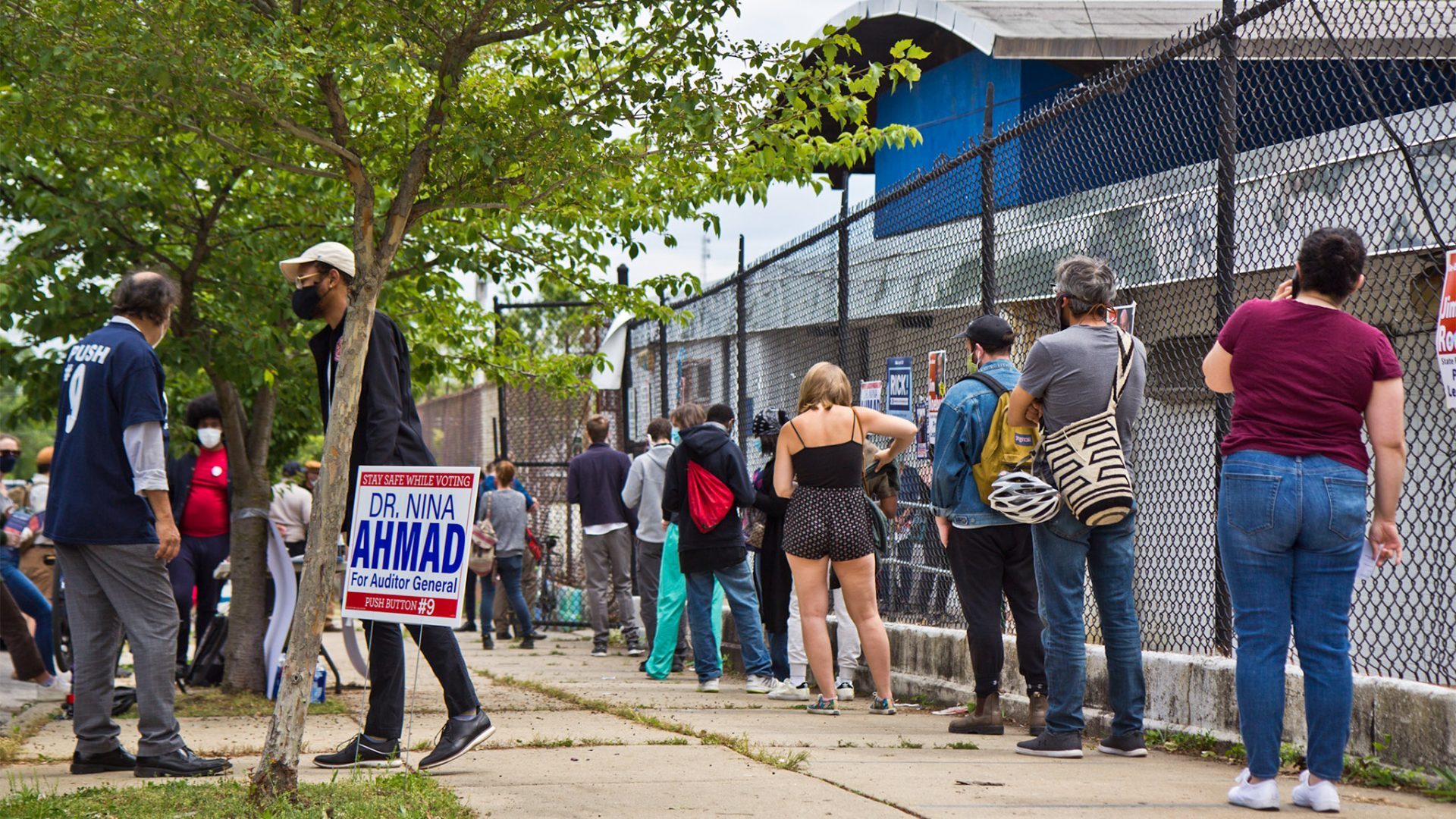
Voters wait in a socially distanced line outside their polling place in Philadelphia on June 23, 2020.
Kimberly Paynter / WHYY

Voters wait in a socially distanced line outside their polling place in Philadelphia on June 23, 2020.
Kimberly Paynter / WHYY

Kimberly Paynter / WHYY
Voters wait in a socially distanced line outside their polling place in Philadelphia on June 23, 2020.

Kimberly Paynter / WHYY
Voters wait in a socially distanced line outside their polling place in Philadelphia.
Are election and health officials prepared to respond to potential coronavirus exposure at the polls during the presidential election in Pennsylvania?
Not quite, it appears, at least not everywhere, based on how things went during the primary.
The matter of notifying voters, election workers, poll watchers and others that they might have been exposed seems like it should be straightforward. Unlike most other mass gatherings, elections provide a way to directly alert participants because of the voter registration database.
But it’s not clear health and election authorities would avail themselves of that resource, should the need arise.
Andrea Johnson, a Philadelphia woman who spent the primary as a poll watcher and later tested positive for COVID-19, recently shared her story with me — including her concern that city officials hadn’t notified voters despite her best efforts to stress to them potential risk at her polling place June 2.
“My whole objective is to make sure that the communities that I serve are safe, … and that we’re made aware,” said Johnson, who hasn’t had symptoms despite her positive result. “People aren’t getting tested, and you don’t know how many people like myself are walking around with a virus, and we don’t know … unless and until we get tested.”
I teamed up with my colleague Katie Meyer of WHYY to look into it.
It turns out, some other counties — including some of the most populous — probably would’ve handled things the same way, we found.
Just two told us otherwise.
Of course, the situation is more complicated than it might appear at first. To start, Philly reportedly has just a dozen contact tracers — though city health officials told Katie they’re increasing the ranks, with 50 staffers in training right now.
Counties’ contact tracing strategies and capabilities vary widely across Pennsylvania.
But it’s “worrisome,” as Centre County Commissioner Michael Pipe put it, that state and county officials aren’t already moving in lockstep when it comes to public notice following a known potential risk of exposure at the polls. Pipe says state officials need to get a plan in place asap.
“We all appreciate they were moving at a very fast clip and trying to take care of a lot of things [before the primary],” Pipe said. “But we’re going to have this pandemic in November. So, they should really have a very robust program for how they notify people, if they get sick at the polls.”
Read the full story here.
An increasing number of Pennsylvania communities have come to rely on state police for local law enforcement. The move might save money, at least in the short-term — but it contributes to problems related to protests in rural communities across the commonwealth. At the center of the issue, Joseph Jafaari writes in his latest for PA Post, is community policing. Read it here.
Under the Regional Greenhouse Gas Initiative, or RGGI, power plants have to pay for the carbon dioxide they emit. That sounds good for the environment, but opponents say the program will kill jobs. Pennsylvania lawmakers heard from both sides amid the Wolf administration’s push to join 10 other states in the program. Rachel McDevitt covered the hearing for StateImpact Pennsylvania.
Lawmakers are expected to vote on a chokehold ban, use-of-force training and policy requirements and other police reforms before departing Harrisburg for summer recess. But none of those bills is poised for final passage just yet. Stakeholders say lawmakers need to keep working on these initiatives now, Ben Pontz reports in his latest for PA Post.
Dashcam footage from the recent tear-gassing of protestors I676 in Philadelphia calls authorities’ accounts of the incident into question. Made public after WHYY requested it, the footage shows a protestor spray-painting part of the squad car’s windshield, obscuring the camera’s view. But an officer is overheard describing protestors as peaceful — counter to officials’ claims that protestors were antagonistic and rocking the squad car before other cops descended on the crowd. More details here from Ryan Briggs.
Must reads
Vox: A new poll shows a majority of Americans support redirecting funds from police to other services
NPR: Protest arrests led to surge of bail fund donations, and impact could be long lasting
U.S. News & World Report: Trump moves to defend monuments
Route Fifty: Conservation could create jobs after the pandemic
LancasterOnline: AG says Lancaster city pharmacy price-gouged hundreds of N95 masks
Associated Press: Bill Cosby granted appeal in Pennsylvania sex assault case
Coronavirus update:
CNN: EU weighs denying entry to Americans amid U.S. coronavirus surge
York Dispatch: 55 new COVID-19 cases in York County mark highest increase to date
WPSU: Centre County sees upswing in COVID-19 cases, largest one-day increase since April 7
WITF: A day in the life of a doctor during coronavirus pandemic
PennLive: Pa. warns of egregious COVID-19 related bills from doctors, dentists
The days of journalism’s one-way street of simply producing stories for the public have long been over. Now, it’s time to find better ways to interact with you and ensure we meet your high standards of what a credible media organization should be.